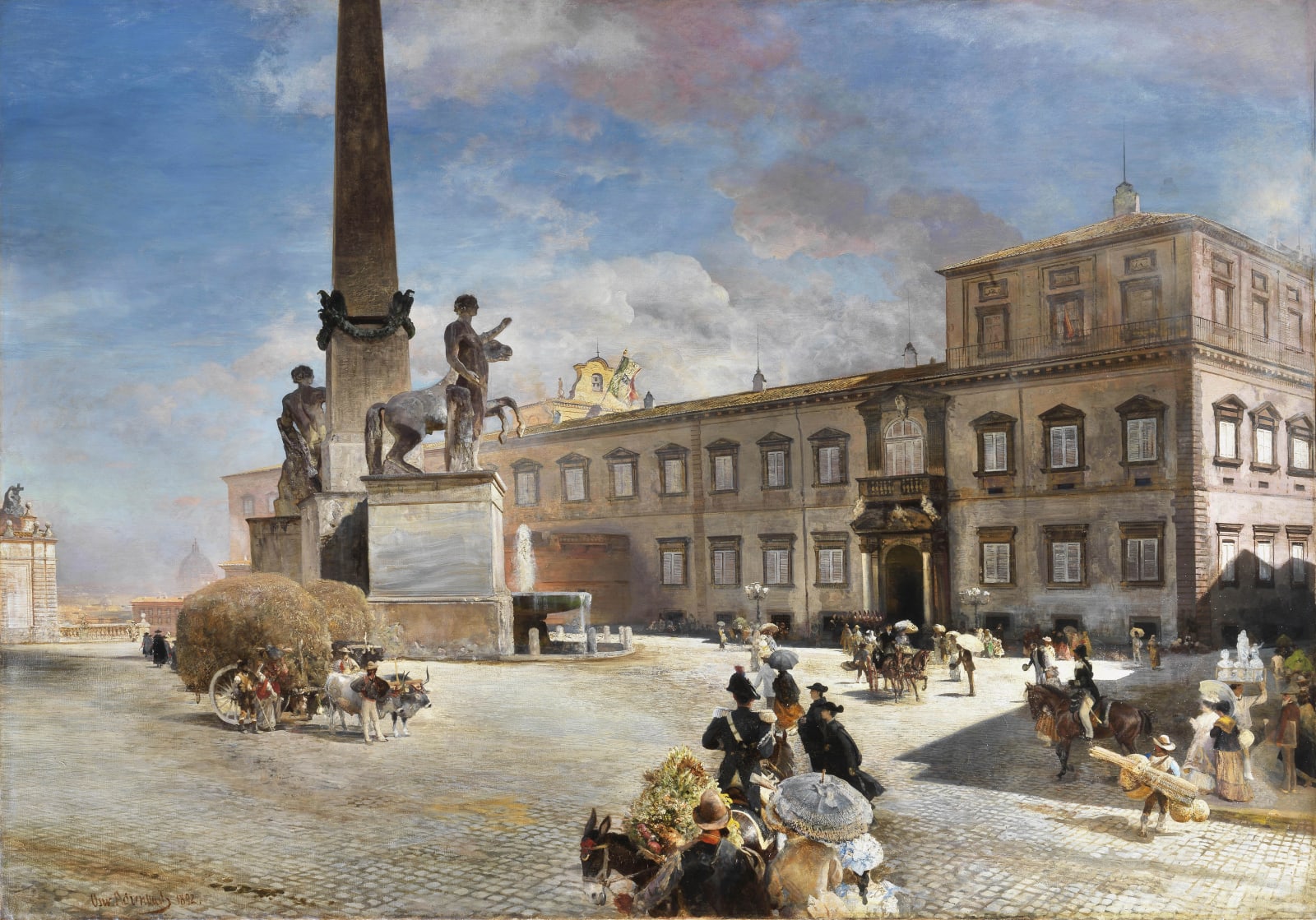Oswald ACHENBACH
Provenance
Caecilie Achenbach, Berlin, 1911.
Private collection, Lindau.
From 1983 on permanent loan to the Düsseldorf Kunstmuseum, inv. n. 1983/82.
Exhibitions
Andreas und Oswald Achenbach. Das "A und O der Landschaft", Kunstmuseum Düsseldorf 1997/98, ill. p. 128/129, sch. p. 221.
There is a preparatory drawing for this view in the Kunstakademie Düsseldorf inv. n. C54.274.
Publications
Die Kunst für Alle, vol. 8, 1892-1893 p. 44.
C. Achenbach, Vom Schreibtish und aus dem Atelier. Oswald Achenbach, p. 441; ill. p. 445.
M. Potthoff: Oswald Achenbach. Sein künstlerisches Wirken zur Hochzeit des Bürgertums. Studien zu Leben und Werk, 1995, ill. 5 pag. 113 and pag. 289, sch. 60.
The painting depicts Piazza del Quirinale in Rome, formerly known as the “Piazza Monte Cavallo”.
On the left we see the imposing “Fountain of the Dioscuri” with the Egyptian obelisk and the sculpture group of the Dioscuri – in other words, Castor and Pollux – that once adorned the entrance to the “Baths of Constantine”, which also stood on the Quirinal Hill.
The centre of the composition is dominated by the majestic Palazzo del Quirinale. The palazzo’s history began in the 16th century when Cardinal Ippolito d’Este had a country villa built here as his summer residence. In 1587 Pope Sixtus V commissioned Domenico Fontana to extend the existing building. Pope Clement VIII, on the other hand, took a particular interest in the gardens, using them as a kind of “salon en plein air”. The palazzo was finally completed by Pope Paul V, who is responsible for the building that we see today.
The Popes used the palazzo as their permanent residence, apart from very short periods of time, from the 17th century onwards. The Palazzo del Quirinale became the residence of the Royal House of Savoy after 1870, and it has been the official residence of the President of the Italian Republic since 1947.
The painting under discussion here dates back to the period of the House of Savoy, in 1892, as we can see from the Italian flag with the coat-of-arms of the House of Savoy floating over the palazzo.
The figure emerging from the palazzo in his carriage is most likely to be King Umberto I, portrayed here with his characteristically large moustache as passers-by make their obeisance.
Various figures people the foreground, including an elegant lady with a parasol and a girl in tow, a Carabinieri officer and two young priests enjoying a walk.
A handful of figures on the right include a ‘souvenir’ hawker selling plaster busts arranged on a tray.
Oswald Achenbach was one of the leading German painters of his day and a prominent member, along with his brother Andreas, of the so-called “Düsseldorf school”. He travelled to Italy on eight separate occasions and his fondness for the peninsula grew with each one of his trips, the first in 1845 and the last in 1895. His trip in 1850 had major impact on his work because while in Rome he met up with Arnold Böcklin (1827–1901) and Anselm Feuerbach (1829–80), both of whom he had known during his student days in Düsseldorf.
Achenbach developed a new way of looking at Italy, succeeding in combining an interest in the realistic portrayal of architecture and the landscape with an intense handling of light.
His reputation and his success went from strength to strength between 1860 and 1890. He focused on Italian views, thus meeting the growing demand from his clientele. He was a member of the Academies of Düsseldorf, St. Petersburg, Rotterdam and Vienna. He painted pictures intended for both the national and international markets, showing his work in Berlin, Vienna, New York, Chicago and Cincinnati. He was represented in New York by the Galerie Goupil of Paris, which had opened a branch in the city in 1848.
JOIN OUR MAILING LIST
Subscribe to our mailing list in order to receive news on new acquisitions, exhibitions, special previews and more!
* denotes required fields
We will process the personal data you have supplied to communicate with you in accordance with our Privacy Policy. You can unsubscribe or change your preferences at any time by clicking the link in our emails.
